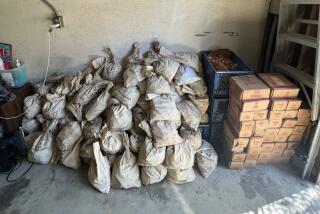A Family Heirloom Should Never Be Sold
- Share via
Question: Enclosed is a photocopy of a sheet of three $20 bills issued by the Farmers Bank of Frankfort, Ky. The bills feature a picture of John Jordan Crittenden, who was elected governor of the state in 1848, in addition to a picture of his second wife. He is my great-great-grandfather, so I am not interested in selling the sheet, but I’d like to know if you could help determine its value.--J.J.C.
Answer: I don’t blame you for not wanting to sell your notes. What you have is a family heirloom, which should be passed down from generation to generation.
Not everyone is fortunate enough to be able to collect in this manner. But there are still plenty of other opportunities, especially with coins. Proof sets and mint sets make wonderful gifts and can mark births, anniversaries and other special occasions in a particular year. Dated gold pieces also are often used in jewelry for a special observance.
I know someone who collects dated Lindbergh memorabilia because the date of Charles Lindbergh’s transatlantic flight also marks his birthday.
In any event, your notes appear to be broken bank notes, so called because they were issued privately between 1800 and 1865 by a number of banks, many of which (but not all) failed. The banking panics of 1819, 1837 and 1857 eventually led to the creation of national bank notes in 1863.
Your sheet, according to a specialist I consulted at the recent Glendale Stamp and Coin Show, is worth about $125. But as you say, it’s not for sale. Broken or not.
Q: My mother recently passed away, and one of the things she left is a huge sack of pennies--pounds and pounds of them. What in the world should I do with them?--P.G.
A: Sort your cents by dates and mint marks. Cents from 1909 to 1958 are each worth 1 1/2 cents and up. Get a coin catalogue to look up values. Specifically, look for S mints and the dates 1909, 1915, 1914-D, 1922-D, 1924-D, 1926-S and 1931-S. Any coin dealer is a potential buyer.
Q: Enclosed is a list of copies that I have of the Numismatist and the Numismatic Scrapbook. Would they be of any value to a collector or a coin store? Also, I would like to know the value of an 1851 1-cent piece and a 1937-D three-legged buffalo nickel.--J.F.F.
A: There is, indeed a market for back copies of coin publications. Prices vary depending upon condition and rarity. You can contact dealers for such material at coin shows and through coin publications. As for your coins, the large cent is worth $5 and up, the three-legged nickel is $75 and up, depending on condition.
Coin News
Canadian coins will be featured in a sale March 28-31 in New York City under the direction of Auctions by Bowers & Merena. A highlight will include the 1921 50-cent piece (pictured) known as the “King of Canadian Coins.” Only 75 to 100 specimens are known to survive. The 416-page catalogue is $20 from Auctions by Bowers and Merena, Box 1224, Wolfeboro, N.H. 03894.
A collection of 20th-Century U.S. gold coins estimated to be worth $5 million was recently graded by the Professional Coin Grading Service. The collection of Steven Duckor, assembled over a 20-year period, contains 117 of the 123 gold coins minted between 1907 and 1933 in the $2 1/2, $5, $10 and $20 denominations. David Hall, PCGS chief executive officer, said the most outstanding rarity in the Duckor Collection is a 1927-D $20, graded as Mint State 65. Hall believes it’s worth “perhaps as high as $1 million.” PCGS grades about 70,000 coins a month. The firm can be contacted at P.O. Box 9458, Newport Beach, Calif. 92658. Phone (714) 250-1211.
Coin Calendar
This Friday, Saturday and Sunday, the American Numismatic Assn.’s Early Spring Convention and Money Show will feature a three-session auction at the Town and Country Hotel in San Diego. Also on tap will be one- and two-day coin grading and encapsulation services by the ANA’s Certification Service. One-day service is $125 per coin; two-day service is $65. Also, the Bureau of Engraving and Printing will offer a souvenir card featuring a replica of an unissued $2 Silver Certificate of 1897. Show hours are 10 a.m. to 6 p.m. Friday and Saturday, 9 a.m. to noon Sunday. Admission is free.
More to Read
Sign up for The Wild
We’ll help you find the best places to hike, bike and run, as well as the perfect silent spots for meditation and yoga.
You may occasionally receive promotional content from the Los Angeles Times.





